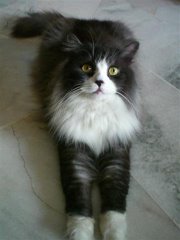I dun really fancy trimming the claws, coz my cats seem not to like it that much..and I'll usually end up in minor love scratches from my kitties..but no can do !
This time around, I'll be sharing some tips for trimming the claws for your feline, as per requested by a member named Marzie though. Thanks for the topic request yea! Here's for you...

Firstly, you'll need some basic tools for the trimming and some basic techniques during the trimming.
Gently stroke your cat's paws often, getting her used to having her paws held before you attempt trimming. Be sure to reward your cat with a special food treat-one that she receives only during claw trimming or some other grooming procedure-during or immediately after trimming. The best time to trim your cat's claws is when she is relaxed or sleepy. Never try to give a pedicure right after a stressful experience or an energetic round of play. Please!!
Your cat should be resting comfortably on your lap, the floor, or a table. Hold a paw in one hand and press a toe pad gently to extend the claw.
 Referring to the pic above:
Referring to the pic above:Notice the pink tissue (the quick) on the inside of the claw. Avoid the quick when you trim the claw; cutting into it will cause pain and bleeding.
Remove the sharp tip below the quick (away from the toe), clipping about halfway between the end of the quick and the tip of claw. If your cat becomes impatient, take a break and try again later, or even days after..
Many people hold the clippers at right angles to the nail, thus cutting across the nail. This tends to make the nail more subject to splitting or fraying. It is better to hold the clippers in a vertical position--that is, up and down, so that the claw is trimmed from bottom to top instead of across the nail. This position help prevent splitting.
If you accidentally clip into the quick, don't panic. The claw may bleed for a moment, but it will usually stop very quickly. Soothe your cat by speaking softly to her and stroking her head. If the bleeding hasn't stopped after a minute or so, try pat on styptic powder to help staunch the bleeding.
My personal tip:I always clip the claws while my kitties are sleeping (a deep sleep, not a nap). It works every time !If' your cat absolutely refuses to allow you to clip tier claws, the professional groomers and vets are always there for you :)
Miaowsss!!!
Info source: www.catscratching.com











